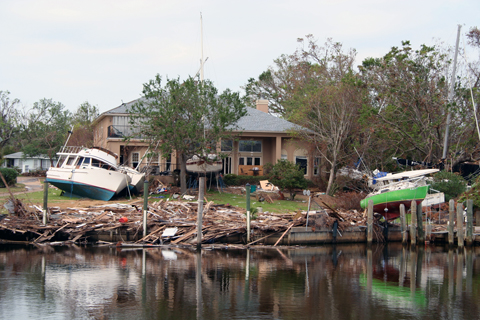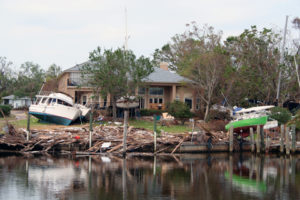
Editor's Note: This article about a hurricane preparedness checklist comes courtesy of P.R.E.P. (Personal Readiness Education Programs), a survival and preparedness school in Florida. Follow P.R.E.P. on Facebook and Twitter.
Time to Review Your Hurricane Preparedness Checklist
Hurricane season officially starts June 1, 2013. How well are you prepared for the storm? It's time to review your hurricane preparedness checklist.
Here are some tips to get you situated before the season begins. Preparedness is key to preventing standing in long lines and paying high prices when a storm is near.
Hurricane Preparedness Checklist: Prepared
 * Take a few minutes to look around your home and property for anything that may become damaged by blowing or standing water. Be ready during the storm to react in the home to structure damage and water intrusion.
* Take a few minutes to look around your home and property for anything that may become damaged by blowing or standing water. Be ready during the storm to react in the home to structure damage and water intrusion.
* Before a storm arrives, consolidate all storm survival supplies to one location in the center of the home. This will make things easier to find in the dark when the power is out and will aid in inventory of supplies and rationing if needed. This is also helpful if you need to evacuate at some point.
* Do you have large trees that could fall on your home? Gusting winds can break large branches and send them across the yard, especially if it’s early in the season when the trees haven’t been exposed to strong winds for a long time and still have their leaves and pine needles. That large tree may be sturdy but standing water may loosen the soil around the roots, leaving an opportunity for the tree to fall later. Keep an eye on any trees that may be located in saturated soils.
* Do you live near canals? During a flood event, roads and canals may appear similar leading many drivers to mistakenly drive into canals. If you aren’t sure, look for mailboxes, if there are none in sight you may be looking at a canal. Make a threat map ahead of time and identify the safest routes.
* Are you in a surge zone? Most coastal areas can be flooded once the storm surge pushes on shore or into ocean inlets. You don’t have to live on the beach to be affected by storm surge. Water can be pushed inland and disrupt the storm sewer drainage system leaving nowhere for rainwater to go until the storm passes. Past experiences show that some communities will drain quicker than others during flooding events. Take this into account for travel or evacuation purposes, as well as your threat map.
Hurricane Preparedness Checklist: Skilled
* After a storm, power will be restored to critical grid areas first, such as hospitals and the largest populations. Report outages early and be ready to survive on your own for a while.
* The recommended 72 hour emergency kit will fall short when you are in the dark for 2 weeks. Have a plan to cook off-grid and be able to wash dishes properly to prevent a food borne illness outbreak in the home. Also keep a good quality meat thermometer in your emergency kit and evac bags for food safety.
* During periods of busy phone circuits, use texting as an alternative to voice. Texting runs on a different system and requires less bandwidth. Use an out of area relative as a family emergency contact. When local lines are down, long distance lines may still operate. Make sure everyone has that phone number to relay messages.
* Use the buddy system to care for each other and be sure to stay properly hydrated. Most injuries happen after the storm due to accidents with tools and bad decisions. Your ability to make good decisions depends heavily on being properly hydrated.
* Drink at a bare minimum a half-gallon of water per day. If you are working in the heat, strive to drink a gallon or more as needed.
Hurricane Preparedness Checklist: Aware
* The right front quadrant of a hurricane is where the most severe weather will be located. This is where there will be increased storm surge and more potential for tornadoes. Severe gusting winds can happen anywhere in the storm.
* Expect weather from all directions. As the storm passes, any item you thought would be shielded from approaching winds may exposed to opposite direction winds later.
From rolling blackouts to hurricanes, floods to tornadoes, power can go out at a moment's notice. If the grid fails, the PowerPot will keep you charging! The PowerPot thermoelectric generator converts any heat source directly into power that charges your USB handheld devices. Get Yours Now


![Best Concealed Carry Guns In 2025 [Field Tested] Wilson Combat EDC X9S 1](https://gundigest.com/wp-content/uploads/Wilson-Combat-EDC-X9S-1-324x160.jpg)


![Best 9mm Carbine: Affordable PCCs [Tested] Ruger Carbine Shooting](https://gundigest.com/wp-content/uploads/Ruger-Carbine-Shooting-100x70.jpg)
![Best AR-15: Top Options Available Today [Field Tested] Harrington and Richardson PSA XM177E2 feature](https://gundigest.com/wp-content/uploads/Harrington-and-Richardson-PSA-XM177E2-feature-100x70.jpg)
